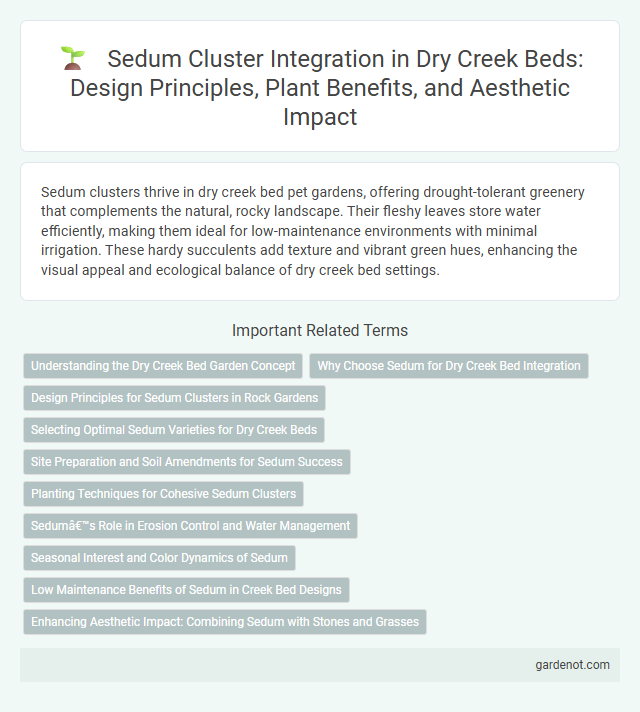Sedum clusters thrive in dry creek bed pet gardens, offering drought-tolerant greenery that complements the natural, rocky landscape. Their fleshy leaves store water efficiently, making them ideal for low-maintenance environments with minimal irrigation. These hardy succulents add texture and vibrant green hues, enhancing the visual appeal and ecological balance of dry creek bed settings.
Understanding the Dry Creek Bed Garden Concept
Sedum clusters thrive in a dry creek bed garden by efficiently retaining moisture while enhancing soil stability with their extensive root systems. These drought-tolerant succulents provide vibrant texture and color contrast, complementing the natural flow of rocks and gravel in the landscape design. Integrating sedum enhances the ecological balance, supporting pollinators and reducing erosion in arid garden settings.
Why Choose Sedum for Dry Creek Bed Integration
Sedum thrives in dry creek beds due to its exceptional drought tolerance and low maintenance requirements, making it ideal for arid environments. Its thick, succulent leaves store water efficiently, supporting survival in rocky, well-drained soils commonly found in dry creek beds. Sedum's diverse varieties provide year-round color and texture, enhancing the aesthetic appeal and erosion control of dry creek landscapes.
Design Principles for Sedum Clusters in Rock Gardens
Sedum clusters in rock gardens thrive when arranged to maximize drainage and sunlight exposure, reflecting their drought-tolerant nature. Strategic grouping based on varying heights and colors enhances visual texture while maintaining the ecological balance of dry creek beds. Prioritizing soil composition rich in gravel and sand supports root health and mimics the plant's native arid environments for optimal growth.
Selecting Optimal Sedum Varieties for Dry Creek Beds
Choosing optimal Sedum varieties for dry creek beds involves prioritizing drought-tolerant species such as Sedum acre, Sedum album, and Sedum spurium, which thrive in well-drained, rocky soils with minimal water retention. These succulents exhibit low maintenance requirements and excellent erosion control due to their dense, mat-forming growth habits. Selecting hardy Sedum cultivars with varied foliage colors and bloom times enhances year-round aesthetic appeal while supporting biodiversity in arid landscaping environments.
Site Preparation and Soil Amendments for Sedum Success
Site preparation for Sedum clusters in a dry creek bed requires thorough soil testing to ensure well-draining conditions, as Sedum thrives in sandy or gravelly substrates with low moisture retention. Incorporating organic matter such as compost or coarse sand improves soil aeration and nutrient availability while avoiding heavy clay amendments that retain water and risk root rot. Adjusting soil pH to a slightly acidic to neutral range (6.0-7.0) enhances nutrient uptake, promoting vigorous Sedum growth in arid, rocky environments.
Planting Techniques for Cohesive Sedum Clusters
Planting Sedum clusters in a dry creek bed requires well-drained soil and strategic spacing to promote healthy growth and prevent overcrowding. Positioning sedum cuttings or small plugs close enough encourages root interconnection, forming a cohesive carpet that stabilizes soil and enhances erosion control. Incorporating organic mulch around clusters conserves moisture and reduces weed competition, ensuring a thriving dry creek bed ecosystem.
Sedum’s Role in Erosion Control and Water Management
Sedum clusters play a crucial role in erosion control within dry creek beds by stabilizing soil with their extensive root systems, reducing sediment displacement. Their succulent leaves efficiently store water, enhancing water retention and slowing runoff during rainfall events. This dual function of soil stabilization and water management makes Sedum an ideal plant for maintaining the structural integrity of dry creek beds.
Seasonal Interest and Color Dynamics of Sedum
Sedum clusters in a dry creek bed provide vibrant seasonal interest with their dynamic color changes throughout the year. In spring and summer, their fleshy leaves exhibit rich green hues, transitioning to warm reds, oranges, and purples in fall, enhancing the creek bed's visual appeal. These drought-tolerant plants maintain structure and texture even in dry conditions, contributing year-round color and resilience to the landscape.
Low Maintenance Benefits of Sedum in Creek Bed Designs
Sedum clusters are ideal for dry creek bed designs due to their drought tolerance and minimal water requirements, significantly reducing maintenance efforts. Their shallow root systems help stabilize soil while thriving in poor, rocky substrates typical of creek beds. Sedum's ability to retain moisture and resist pests ensures long-lasting ground cover with minimal intervention.
Enhancing Aesthetic Impact: Combining Sedum with Stones and Grasses
Sedum clusters create vibrant, low-maintenance focal points within a dry creek bed, their succulent leaves contrasting sharply with smooth river stones and wispy ornamental grasses. The interplay of texture and color enhances visual depth and seasonal interest, while the drought-tolerant nature of Sedum complements the arid environment of the creek bed. Incorporating varied stone sizes and native grasses amplifies the natural aesthetic, creating a balanced, harmonious landscape that thrives with minimal care.
Sedum cluster Infographic

 gardenot.com
gardenot.com